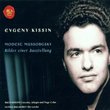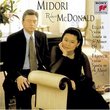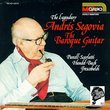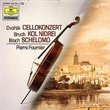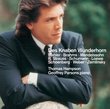| All Artists: Antonio Vivaldi, Andrea Marcon, Giuliano Carmignola, Venice Baroque Orchestra Title: Antonio Vivaldi: Late Violin Concertos (RV177 / RV222 / RV273 / RV295 / RV375 / RV191) - Giuliano Carmignola / Venice Baroque Orchestra / Andrea Marcon Members Wishing: 0 Total Copies: 0 Label: Sony Original Release Date: 1/1/2001 Re-Release Date: 8/7/2001 Genre: Classical Styles: Forms & Genres, Concertos, Historical Periods, Baroque (c.1600-1750), Instruments, Strings, Symphonies Number of Discs: 1 SwapaCD Credits: 1 UPC: 696998936225 |
Search - Antonio Vivaldi, Andrea Marcon, Giuliano Carmignola :: Antonio Vivaldi: Late Violin Concertos (RV177 / RV222 / RV273 / RV295 / RV375 / RV191) - Giuliano Carmignola / Venice Baroque Orchestra / Andrea Marcon
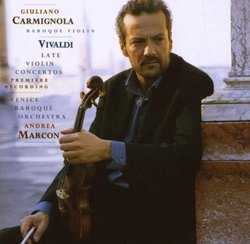 | Antonio Vivaldi, Andrea Marcon, Giuliano Carmignola Antonio Vivaldi: Late Violin Concertos (RV177 / RV222 / RV273 / RV295 / RV375 / RV191) - Giuliano Carmignola / Venice Baroque Orchestra / Andrea Marcon Genre: Classical
This premiere recording of six Vivaldi concertos is full of surprises. The works are entirely unknown because, unlike his other compositions, they were written not for publication but for substantial private commissions... more » |
Larger Image |
CD DetailsSynopsis
Amazon.com's Best of 2001 This premiere recording of six Vivaldi concertos is full of surprises. The works are entirely unknown because, unlike his other compositions, they were written not for publication but for substantial private commissions from wealthy patrons. Dating from his most mature years, they exhibit a style very different from his earlier concertos, which often sound almost mass-produced. Though they are still cast in the customary three movements and are full of the usual sequences, they are more unpredictable, dramatic, and daring; adventurous in form, harmony, and texture; with sudden contrasts of mood, character, and expression. The slow movements are meltingly beautiful, but no two concertos are alike, either in detail or overall effect. Some movements hardly seem to hang together; they appear to consist of collages of motives, punctuated by bursts of virtuosity. The performance is equally unconventional. Giuliano Carmignola, as he demonstrated on his previous Vivaldi recording, is a formidable virtuoso who projects spontaneity, vitality, and expressiveness. In solo parts bristling with runs, often into the highest register, trills, double stops, and arpeggios, he displays breathtaking speed and facility, total command of every style of bowing and articulation, and a ravishing, powerful, infinitely variable tone. Except for the harpsichord, the orchestral instruments, tuned to normal pitch, hardly sound Baroque--their tone is full-blooded and varied. By using two harpsichords and a lute, conductor Andrea Marcon achieves percussive effects sometimes resembling gunshots, and the playing is by turns brilliant, lyrical, and exciting. --Edith Eisler Similarly Requested CDs
|
CD Reviews#1 hit record! Jonathan J. Casey | the twin cities | 09/19/2001 (4 out of 5 stars) "I'm distressed to hear this recording described as music that "doesn't sound baroque" as if it were a good thing. Why would you feel compelled to buy music you don't actually like? It seems obvious to me that you should listen to what you enjoy, rather than trying to force baroque music to sound like what you're used to. In fact, the existence of period instrument orchestras such as the Venice Baroque can be traced back to a reaction against the plodding, large orchestras of yesteryear. While they may not play at period pitch (slightly lower than today's concert "A"), this group performs with smaller numbers and the lighter textures afforded by gut strings and early bow design. What we get may not be "authentic," per se, but it is certainly a more favorable listening environment in which the music of Vivaldi can truly shine. Conductor Marcon plays harpsichord along with a second keyboardist. An archlute rounds out the continuo- but most people are probably here to hear Carmignola. It seems he's being groomed for the level of stardom that has overlooked historically-informed performers so far (probably the next biggest name in baroque violin, Andrew Manze, is still small beans compared to a Shaham or Mutter). I believe he will be well suited to it, as he commands great skill and passion on the instrument. While I avoided the first release of this group (I don't need a third recording of the four seasons, do I?) I was interested to hear them, and these "world premiere" recordings of obscure Vivaldi works. I'm pretty happy with it. Though they aren't as groundbreaking as Europa Galante or Il Giardino Armonico, the Venice Baroque are a fine ensemble, and Carmignola has a long career ahead of him, I'm sure. This is baroque music, to be sure, with a nod to the Galant which was, I suppose, looking ahead to Romanticism. Don't expect Wagner, though. This is still Vivaldi, 18th century, pre-Sturm und Drang. Give it a listen- you might even enjoy yourself." High Standards Met in this BreakThrough Baroque Recording rodboomboom | Dearborn, Michigan United States | 09/13/2001 (5 out of 5 stars) "Appetite wetted for this collection through clips played on beethoven.com, which made me want more.This is truly a beautiful recording of Vivaldi concertos never recorded before, due to the business decision made in the composer's later years to not mass distribute his compositions.Thus, these concertos burst forth in the new, more non-conventional style. Not in the style of the Four Seasons, these are glorious, non-symmetrical freedom. Musical instruments of the period are unlike any this reviewer has heard, they do sound as another reviewer remarked: "unbaroque." These strings sing and roar at times, sensitive and plucked at others. Brilliance pours forth from this disc. Truly enjoyable!" Splendidamente Brillante! The English Chap | Pennsylvania, USA | 03/17/2002 (5 out of 5 stars) "No orchestral group captures classical Baroque and Vivaldi better than the Venice Baroque Orchestra. These scholars have perfected the Baroque style, and have epitomised Antonio Vivaldi's late style with a flowing grace. Vivaldi happens to be my favourite composer, and being a violinist myself, I naturally appreciate the Baroque style and the ability to play it right. Giuliano Carmignola does a "magnifico" job at executing these concerto's in a true Baroque sense. The Venice Baroque Orchestra never ceases to amaze me. I only wish there were more recordings of them. I also wish there were more Antonia Vivaldi recordings. The concertos on this recording were some of Vivaldi's last works, and he never had them published or distributed. In fact this recording is the very first recording of these concertos! Vivaldi, after directing them gave or sold these pieces to friends and acquaintances and they have been kept in the families for generations, and not until the Venice Baroque Orchestra performed and recorded them did they become heard by the vast public. Concerto is E Minor happens to be my favourite on this CD and really captures Vivaldi's late style. In order to compete with the younger composers of the time, Vivaldi was forced to write more passionate and powerful pieces. As with everything he composed, Vivaldi did it with perfection. This "red headed priest" reached his climax towards the end of his life, in my opinion, and these concertos are evidence of that climax. This is an ecellent recording of fine classical baroque...don't hestitate...acquire this...you won't regret it."
|

 Track Listings (18) - Disc #1
Track Listings (18) - Disc #1